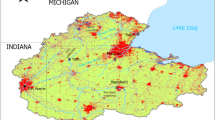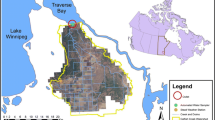Abstract
Environmental self-monitoring is a government requirement for Swedish process industries. This includes sampling and analysis of recipient water that might be adversely affected by emissions. The requirements for accredited analytical methods are strict, with well-defined measurement uncertainties, but estimations of the attendant sampling variability are seldom required, presented, or evaluated in environmental surface water sampling. The goal of this study was to perform an initial evaluation of the measurement variability for surface water sampling within the self-monitoring program for a large mining company in northern Sweden. The results indicate that the method for evaluation of sampling and measurement variability itself affects the results obtained. Therefore, the evaluation scope must be clearly defined in advance, so that the most appropriate approach, resulting in a realistic quantification of total variability, can be selected. This study shows that duplicate sampling experiments result in significantly larger sampling variability estimates when accounting for ambiguities in the sampling protocol than similar experiments under repeatability conditions. This is due to large temporal variations in stream flux and analyte concentrations in the evaluated sampling targets. The ambiguities in different sampling protocols must be fully described and considered when designing empirical evaluation experiments to allow valid evaluation of the total sampling and measurement system variability. An automated sampler using volume-proportional sampling to collect increments for composite samples is recommended to reduce unnecessary sampling variability and address significant temporal changes in stream flux and analyte concentrations appropriately.
Zusammenfassung
Für die verarbeitende Industrie in Schweden ist Eigenkontrolle im Umweltschutz eine staatliche Vorgabe. Diese schließt die Probennahme und Analyse von Vorflutern ein, die emissionsbedingt nachteilig beeinflusst werden können. Die Forderungen zur Akkreditierung der Analysemethoden sind streng und mit wohl definierten Messunsicherheiten belegt, selten jedoch werden im Rahmen der Probenahme von Umweltproben aus Oberflächengewässern Abschätzungen der Stichprobenvariabilität gefordert, dargestellt oder bewertet. Ziel der vorliegenden Untersuchung war es, eine Erstbewertung der Stichprobenvariabilität der im Rahmen der Eigenkontrolle durchgeführten Oberflächenwasserprobenahme eines großen Bergbauunternehmens in Nordschweden durchzuführen. Die Ergebnisse weisen darauf hin, dass die Vorgehensweise zur Bewertung der Stichproben- und Messvariabilität selbst Einfluss auf die erzielten Ergebnisse hat. Aus diesem Grunde muss der Bewertungsrahmen im Vorhinein klar definiert sein, so dass der bestgeeignetste Ansatz gewählt werden kann, um zu einer realistischen Quantifizierung der Gesamtschwankungsbreite zu gelangen. Die Studie zeigt, dass Duplikatprobenahmetests, die Mehrdeutigkeiten der Probenahmevorschrift berücksichtigen, zu signifikant höheren Stichprobenvariabiltäten führen als vergleichbare Experimente unter Wiederholbedingungen. Dies ist starken zeitlichen Schwankungen von Durchflussmenge und Analytkonzentrationen in den beprobten Umweltmedien geschuldet. Uneindeutigkeiten in den verschiedenen Probenahmevorschriften müssen vollständig beschrieben und berücksichtigt werden, wenn empirische Experimente zur verlässlichen Ableitung von Gesamtmessunsicherheiten konzipiert werden sollen. Empfohlen wird der Einsatz automatischer Probenahmesysteme mit Entnahme volumenproportionaler Teilproben und deren Vereinigung zu Mischproben, um die vermeidbare Stichprobenvariabilität zu verringern und signifikante Schwankungen von Durchflussmenge und Analytkonzentrationen über die Zeit angemessen zu berücksichtigen.
Resumen
El autocontrol ambiental es un requisito del gobierno para las industrias de procesos suecas. Esto incluye el muestreo y el análisis del agua del receptor que podría verse afectada por las emisiones. Los requerimientos para los métodos analíticos acreditados son estrictos, con incertidumbres de medición bien definidas, pero las estimaciones de la variabilidad de muestreo concomitante rara vez son requeridas, presentadas o evaluadas en el muestreo ambiental de aguas superficiales. El objetivo de este estudio fue realizar una evaluación inicial de la variabilidad de medición para el muestreo de aguas superficiales dentro del programa de autocontrol de una gran empresa minera en el norte de Suecia. Los resultados indican que el método para evaluar la variabilidad del muestreo y la medición en sí afecta los resultados obtenidos. Por lo tanto, el alcance de la evaluación debe definirse claramente por adelantado, de modo que se pueda seleccionar el enfoque más apropiado, que resulte en una cuantificación realista de la variabilidad total. Este estudio muestra que duplicar los experimentos de muestreo dan como resultado estimaciones de variabilidad de muestreo significativamente mayores cuando se tienen en cuenta las ambigüedades en el protocolo de muestreo que los experimentos similares en condiciones de repetibilidad. Esto se debe a las grandes variaciones temporales en el flujo de la corriente y en las concentraciones de analito en las muestras. Las ambigüedades en los diferentes protocolos de muestreo deben estar completamente descriptas y consideradas cuando se diseña los experimentos de evaluación para permitir una evaluación válida de la variabilidad total del sistema de muestreo y medición. Se recomienda un muestreador automatizado que use un muestreo proporcional al volumen para recolectar incrementos para muestras compuestas para reducir la variabilidad innecesaria del muestreo y abordar los cambios temporales significativos en el flujo de la corriente y en las concentraciones de analito de manera apropiada.
抽象
自我环境监测是瑞典政府对加工行业的要求。自我环境监测需要对接受废水排放的水体进行取样和分析。人们对分析方法的可靠性提出了要求严格,也明确定义了测量不确定性,但是对地表水环境监测取样的变异性估计却考虑、要求和评价较少。本研究旨在初步评价瑞典北部一个大型矿业公司自我环境监控方案的地表水取样变异性。结果表明,取样和测量变异性的评价方法本身也影响最终结果。为此,必须预先定义评价尺度,才能选出可定量评价总体变异性的最佳方法。研究表明,用副份样本试验解释取样协议的模糊性比用可重复条件的相似实验产生的样本变异估计更大。这是由被评价的目标取样河流的流量和分析物浓度的大尺度时间变化引起。当设计经验评价试验以获取可靠的取样和测量总体变异估计时,必须全面考虑不同取样协议的模糊性。建议使用一种按体积比采集增量的自动采样器,以减少不必要的取样变异性和适当处理河流流量和分析物浓度的变异性。




Similar content being viewed by others
References
Botta F, Lepot B, Leoz-Garziandia E, Morin A (2012) Estimation of sampling uncertainty in lake-water monitoring in a collaborative field trial. Trends Anal Chem 36:176–184
Danish S (2013) DS 3077 representative sampling—horizontal standard. Danish Standards Foundation, Nordhavn
Esbensen KH (2016) Pierre Gy (1924–2015): a monumental scientific life. TOS Forum 6:39–46
Esbensen KH, Paasch-Mortensen P (2010) Process Sampling: theory of sampling—the missing link in process analytical technologies (PAT). In: Bakeev KA (ed) Process analytical technology, 2nd edn. Wiley, Chichester, pp 37–80
Esbensen KH, Wagner C (2014) Theory of sampling (TOS) vs. measurement uncertainty (MU)—a call for integration. Trends Anal Chem 57:93–106. https://doi.org/10.1016/j.trac.2014.02.007
Esbensen KH, Wagner C (2016) Sampling quality assessment: the replication experiment. Spectr Eur Asia 28(1):20–25
Esbensen KH, Friis-Petersen HH, Petersen L, Holm-Nielsen JB, Mortensen PP (2007) Representative process sampling—in practice: variographic analysis and estimation of total sampling errors (TSE). Chemometr Intell Lab Syst 88:41–59. https://doi.org/10.1016/j.chemolab.2006.09.011
Gammons CH, Milodragovich L, Belanger-Woods J (2007) Influence of diurnal cycles on metal concentrations and loads in streams draining abandoned mine lands: an example from High Ore Creek, Montana. Environ Geol 53:611–622. https://doi.org/10.1007/s00254-007-0676-z
Grøn C, Bjerre Hansen J, Magnusson B, Nordbotten A, Krysell M, Jebjerg Andersen K, Lund U (2007) Uncertainty from sampling - a nordtest handbook for sampling planners on sampling quality assurance and uncertainty estimation. Nordtest TR-604. Nordic Innovation Centre, Oslo. ISSN 0283-7234
Guigues N, Desenfant M, Lalere B, Vaslin-Reimann S, Eyl D, Mansuit P, Hance E (2016) Estimating sampling and analysis uncertainties to assess the fitness for purpose of a water quality monitoring network. Accredit Qual Assur 21:101–112. https://doi.org/10.1007/s00769-015-1186-4
Gy P (1979) Sampling of particulate materials, theory and practice. Elsevier, Amsterdam. ISBN: 9780444601353
Gy P (1998) Sampling for analytical purposes. Wiley, Chichester
Gy P (2004) Sampling of discrete materials—a new introduction to the theory of sampling I. qualitative approach. Chemometr Intell Lab 74:7–24
Henjum MB, Hozalski RM, Wennen CR, Novak PJ, Arnold WA (2010) A comparison of total maximum daily load (TMDL) calculations in urban streams using near real-time and periodic sampling data. J Environ Monit 12:234–241
Lyn JA, Ramsey MH, Dmanat AP, Wood R (2007) Empirical versus modelling approaches to the estimation of measurement uncertainty caused by primary sampling. Analyst 132(12):1231–1237
Nimick DA, Cleasby TE, McCleskey RB (2005) Seasonality of diel cycles of dissolved trace-metal concentrations in a Rocky Mountain stream. Environ Geol 47:603–614
Pitard FF (1993) Pierre Gy’s sampling theory and sampling practice: heterogeneity, sampling correctness, and statistical process control. CRC Press LLC, Boca Raton (ISBN : 0-8493-8917-8)
Ramsey MH (1998) Sampling as a source of measurement uncertainty: techniques for quantification and comparison with analytical sources. J Anal Atom Spectrom 13:97–104
Ramsey C (2014) The Aloha Sampler™: concept, objective, design and implementation. TOS Forum 3:12–14
Ramsey MH, Thompson M (2007) Uncertainty from sampling, in the context of fitness for purpose. Accred Qual Assur 12:503–513. https://doi.org/10.1007/s00769-007-0279-0
Ramsey MH, Thompson M, Hale M (1992) Objective evaluation of precision requirements for geochemical analysis using robust analysis of variance. J Geochem Explor 44:23–36
Ramsey MH, Geelhoed B, Wood R, Damant AP (2011) Improved evaluation of measurement uncertainty from sampling by inclusion of between-sampler bias using sampling proficiency testing. Analyst 136(7):1313–1321
Rode M, Suhr U (2007) Uncertainties in selected river water quality data. Hydrol Earth Syst Sc 11:863–874
Westerberg I, Huseby Karlsen R (2017) Vattenföringsmätningar i Liukattijoki och Mertaseno. Yearly technical report for LKAB. Swedish Environmental Research Institute, Stockholm
Ylipää M, Björnfot M (2018) Koncentrationsvariation i bräddvattnet vid utökad magasinering i klarningsmagasinet. Internal technical report. LKAB, Kiruna
Acknowledgements
The authors acknowledge the environmental sampling staff and laboratory staff at LKAB for all their help during the experiments within this study. We also thank LKAB for allowing publication of this study.
Author information
Authors and Affiliations
Corresponding author
Rights and permissions
About this article
Cite this article
Engström, K., Olausson, L. & Esbensen, K.H. Experimental Evaluation of Surface Water Sampling Variability for Environmental Monitoring in Iron Ore Operations. Mine Water Environ 38, 353–365 (2019). https://doi.org/10.1007/s10230-019-00598-1
Received:
Accepted:
Published:
Issue Date:
DOI: https://doi.org/10.1007/s10230-019-00598-1




